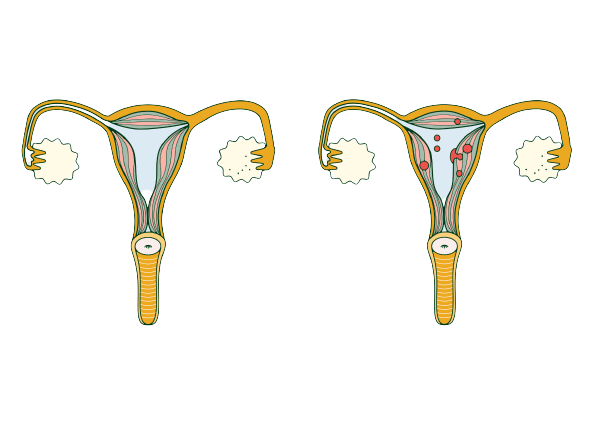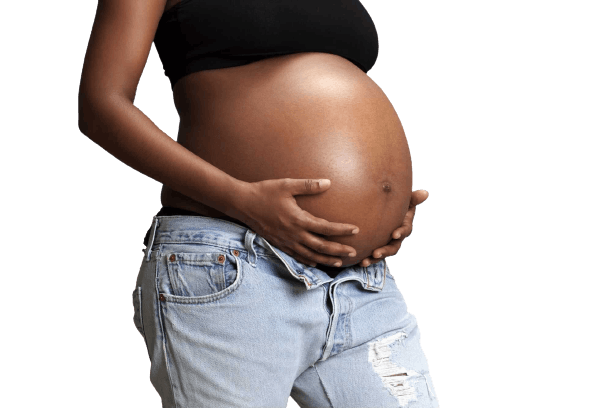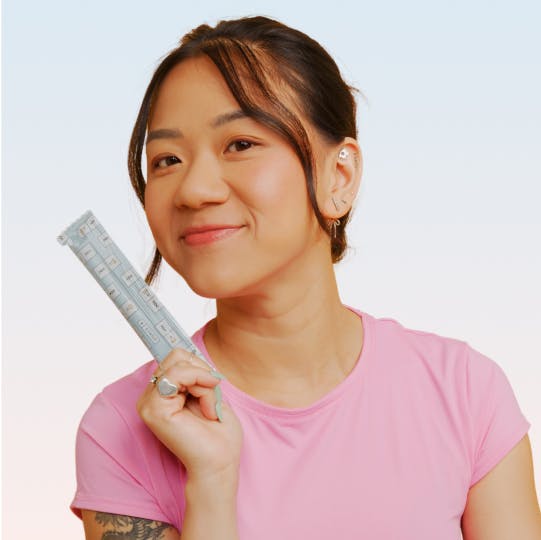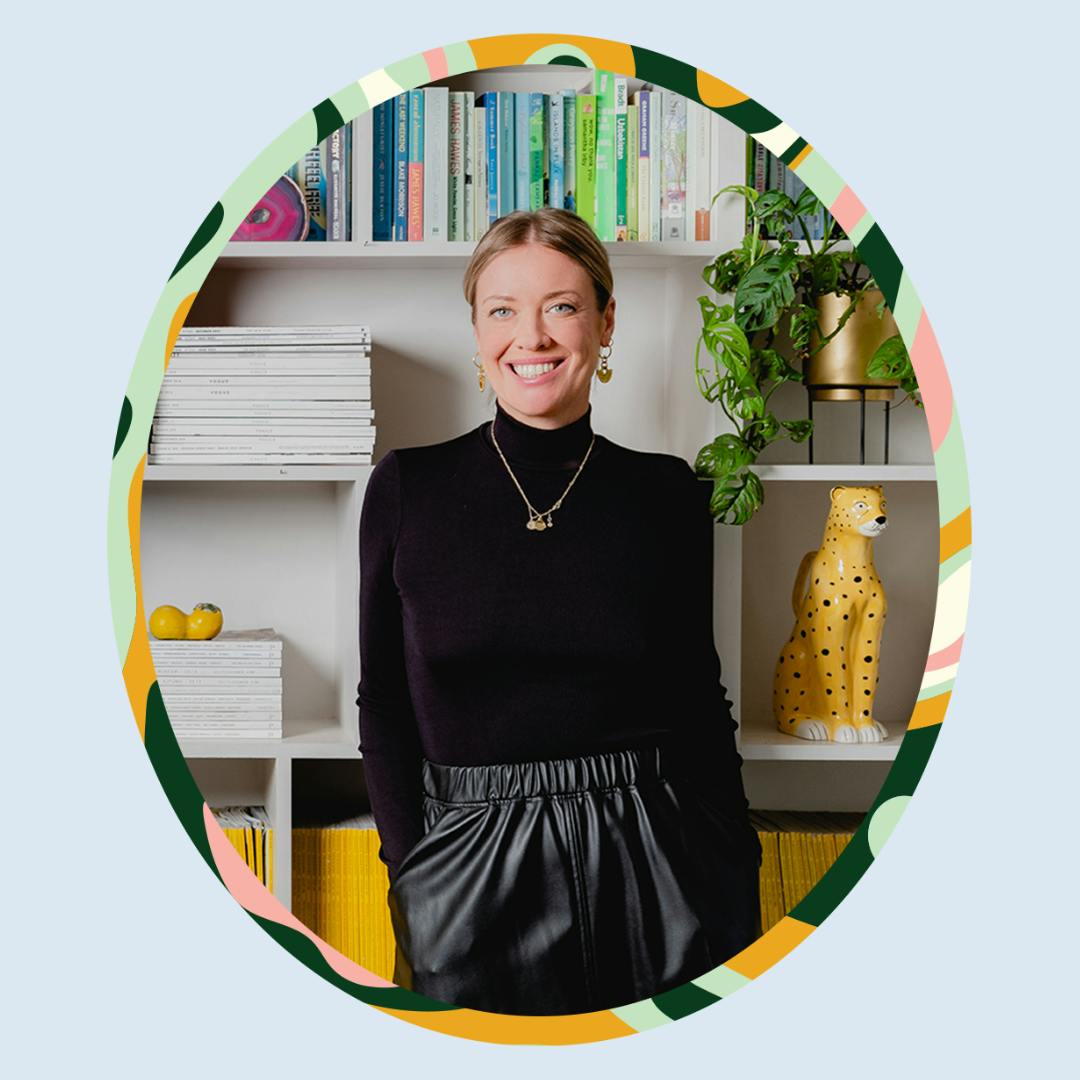Table of contents
1. Adenomyosis diagnosis
2. What is adenomyosis?
3. The gender health gap
4. Adenomyosis and pregnancy
Written by Ellie Fazan
Illustrated by Erin Rommel Sabrina Bezerra
Adenomyosis diagnosis
“Nice nail varnish,” the doctor says as she touches my bare foot. My legs are in stirrups in a darkened room, and the doctor is poking a dildo cam inside me, pressing into my inner walls. After years of wanting a baby but not having anyone to make one with, I finally plucked up the courage to ask a friend if he wanted to co-parent with me. He said yes. So here I am. My first trans-vaginal scan. The doctor says I have a great ovarian reserve (for my age) and with no history of fertility issues like lots of women undergoing IVF my age, I feel confident. Maybe even ever so slightly smug.
But then she says, “Now not to worry.” There’s a pause. A pregnant one. Or in my case a not pregnant one. What turns out could be a not very likely to become pregnant pause. “But there’s a possibility you have Adenomyosis.” It sounds like add-en-o-my-OH-sis. Not a word I’ve heard before. I say “Can you repeat that?” She says it again. “Add-en-o-my-OH-sis.”
Take the pain out of your period
90% of us experience period pain, and when left unmanaged it leads to us losing 150 million productive work days per year.

“What’s that?” I’m shaken. There’s nothing like the words, “Now not to worry,” to tell you that there is something very much to be worried about. “Put your clothes back on and we’ll talk at my desk.” Here she explains that Adenomyosis is a condition that affects the womb. The womb is lined by a layer of endometrial cells which shed each month to create a period. In Adenomyosis some of these cells have migrated into the wall, making a micro period – like a bruise – inside it. There is some evidence that it can contribute to early miscarriage, but many women with it have children easily. In fact she believes these studies are skewed as it’s often only diagnosed in women already undergoing fertility treatment for other reasons. At the time I felt like she was sugar coating it, now I realise that there’s nowhere near enough knowledge about it.

What is adenomyosis?
When I leave, tearful, she tells me firmly, “No googling.” Of course I instantly Google it.The first thing the internet screams back is “infertility” and “hysterectomy” in bold type. Now I’m afraid. One of the main symptoms are heavy periods and intense pain or cramping. I have so many questions: Are my painful periods not normal? It’s impossible to say how many women in the general population have it because it so often goes undiagnosed, but a study done by Naftalin in 2012 showed that in as many as 20% of women attending a general gynaecological clinic, Adenomyosis was present. If it’s so common, why is it so unknown? How, at 40, can I be diagnosed with something that I’ve never heard of?
“
In 20% of women attending a general gynaecological clinic, Adenomyosis was present. If it’s so common, why is it so unknown?
“This condition is difficult to diagnose as the symptoms are common and affect a lot of women,” says Dr Ayanthi Gunasekera, a Specialist Registrar in gynaecology at London Gynaecology. “A large proportion of women have heavy and painful periods and accept the symptoms as ‘normal for me’. When they do seek medical attention, often the doctors would start medical treatment to control symptoms and a scan may not be carried out or may not actually pick up the condition.”

“This condition is difficult to diagnose as the symptoms are common and affect a lot of women,” says Dr Ayanthi Gunasekera, a Specialist Registrar in gynaecology at London Gynaecology. “A large proportion of women have heavy and painful periods and accept the symptoms as ‘normal for me’. When they do seek medical attention, often the doctors would start medical treatment to control symptoms and a scan may not be carried out or may not actually pick up the condition.”
Sarah Rose McCann started @mypelvicpain on Instagram to raise awareness of the condition after years of suffering from chronic pain. “I found out I had Adenomyosis by chance,” she says. “After my endometriosis excision surgery I was still experiencing pain but the doctors told me it was psychosomatic. I got a second opinion and it showed up on an MRI scan.” While it tends to be found in older women, this is not always the case, and as awareness grows, the condition is more often diagnosed in younger people. Another person I spoke to was a teenager when she was rushed to hospital in excruciating pain. Doctors told her mum she had mental health problems and that period pain was “one of those things.” I recall once as a schoolgirl lying down in a car park moaning in pain, and being told to grin and bear it. I regularly wake sweating in the night in terrible agony. But it just lasts for 48 hours and then it’s back to normal. And I thought this was normal. Newsflash. It’s not.
I wouldn’t describe my pain as debilitating, but for some it really is. “Living with Adenomyosis pain feels like there is something trapped inside your uterus wanting to fall out. It’s pressure in between your vagina that radiates down your legs, nausea, back pain, vomiting, bladder pressure and bowel pain,” says McCann. It’s common for her to be out of action for at least a week each month. That adds up to three months a year! Women deserve better than this.
“
I can’t help but wonder, is it because we live in a society where women's pain is taken less seriously than men’s?
Sure, pain can be associated with an imbalance of prostaglandins during your period, as well as stress, smoking, poor diet or anxiety – all of which are treatable – but it also can be associated with serious medical conditions. Fibroids, Endometriosis as well as Adenomyosis all can cause chronic pain. Why didn’t I speak up sooner? I can’t help but wonder, is it because we live in a society where women's pain is taken less seriously than men’s?
The gender health gap
Adenomyosis has only recently come to the fore because of grassroots campaigns, led by sufferers rather than medical professionals. But Adenomyosis still doesn’t even have its own guidelines from the National Institute of Healthcare and Excellence (NICE). Neither is it recognised as a gynaecological condition on their website. Researching this story, finding facts, verified information or even experts to talk to has been all but impossible because there are no dedicated experts, national charity or even registered support groups. “I ask myself why all the time,” says Sarah. “The only answer I can find is that it’s dismissed and not taken seriously, because it’s considered a disease that only impacts older people and people with uteruses, therefore it’s not prioritised. There is less research, less information and less time devoted to it. The reality is that if you’re not a white cis male, you’re going to meet barriers to access care. We need to break down those barriers so that accessing care is an equal playing field.”
“
Adenomyosis still doesn’t even have its own guidelines from the National Institute of Healthcare and Excellence (NICE)
Can healthcare providers really be steeped in misogyny? In an article by Siobhan Fenton on sexist stereotypes and women’s pain for the Independent, she says: "Research has found that in A&E, when women and men present the same severity of abdominal pain, men wait an average of 49 minutes before being treated, while the average wait for women is 65 minutes.” Fenton continues: “One reason for this gender disparity may be that doctors wrongly perceive women are being more irrational and emotional than men, and therefore dismiss their complaints about pain as being all in the mind rather than having a physical basis. Clinical studies have also found that doctors are more likely to think women’s pain is caused by emotional issues rather than physical causes, even in the presence of clinical tests which show their pain is real.” I’m appalled.
Adenomyosis and pregnancy
But for me, there was good news. Although an MRI scan confirmed the diagnosis, it’s mild: a small focal spot of Adenomyosis on the posterior wall of my uterus. “In such cases there is usually no impact on fertility and pregnancy can often help the condition by blocking the periods for the duration of pregnancy and more,” says Gunasekera. The reality is, if I had a partner to have a baby with “naturally”, I might never have known I had it. I’m lucky. In more advanced cases, where the uterine cavity is enlarged significantly, it can make it harder for women to get pregnant. “Fertility stuff is quite a sensitive topic for me,” says McCann.

“Everyone’s fertility experiences will be different. I have been told that my Adenomyosis will impact my chances but the reality is I’m torn regarding children, in my ability to get pregnant or be a parent to the guilt of what if I pass on my genes to another human.”
As the internet warned me, the only definitive treatment is a hysterectomy. “But that would only be considered for extreme cases resistant to treatment where the family is already complete,” says Gunasekera. “The Mirena intrauterine device is also helpful in reducing the symptoms significantly, as is the pill. Uterine artery embolisation (UAE) is a treatment usually reserved for fibroids but is also very effective for treating Adenomyosis.” A quick check on the Government research register reveals that more work is being done. Although there’s no diet proven to help (again, medicine suffers from a serious lack of research on how nutrition can support our physical and mental health). For the last year I’ve been working with a health coach, avoiding inflammatory foods, including gluten, and eating a good amount of fibre and iron rich foods as well as food rich in essential fatty acids. This has definitely helped my period pain (plus my skin actually glows). I’m hopeful for the future. Until recently, periods and women’s problems were not something you spoke about openly, but as more people are prepared to talk about their pain, awareness grows. I’ve found an unlikely support network on Instagram, and here I am, writing about my periods for a website, as I start the process of IVF.






